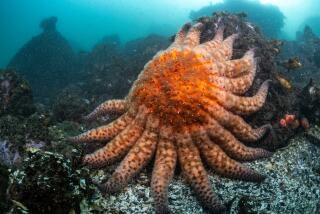Putting the Seal in Seal Beach
- Share via
Although it’s been more than 40 years, Kris Lindstrom still lights up when he remembers family outings to see the seals at Seal Beach. If the time was right, there would be dozens sunning themselves along the shoreline. But sometimes, patience was required.
“All you had to do was sit quietly on the beach and they would come,” said Lindstrom. One of his favorite childhood photos is a grainy black-and-white shot of himself at 4 years old, sitting on the sand, with mounds of seals snoozing peacefully in the background.
Glimpses of the playful mammals that entertained beach-goers and gave the seaside community its name and identity are now rare. A proposal for an unprecedented conservation project would change that by reintroducing an entire marine ecosystem along Orange County’s northernmost coastline.
One of the goals? To lure the seals back to Seal Beach.
The Sierra Club is working with the Seal Beach Chamber of Commerce to build support for the local project, part of a larger coastal waters restoration effort. The proposal’s success is far from certain. The cost has yet to be determined. It first requires the approval of state legislators and the California Coastal Commission. And some critics say it’s too ambitious.
But supporters are confident that work could begin as early as this year, in part because Seal Beach city leaders, business owners and environmental activists support it.
“It draws attention to the fact that the name Seal Beach was rooted in a reality that no longer exists,” said Susan Jordan, board member of the League for Coastal Protection, who applauds efforts to return to that reality. “The reason it doesn’t exist anymore is because of the impact that development has had on habitat along that shoreline.”
A citywide “Save Our Seals” fund-raising campaign gets underway this month. The plan follows a relatively simple theory, said Bruce Monroe, a Seal Beach businessman and Sierra Club member: Improve the wetlands and the rest will follow.
Central to the proposal, Monroe said, are planting kelp forests offshore, and mangrove trees and sea grass in the wetlands areas in the Seal Beach National Wildlife Refuge, which lies within the Seal Beach Naval Weapons Station.
The sea grass beds and the mangrove trees’ root systems would attract the kinds of creatures that seals love to feast upon. Although a typical seal diet centers on sardines, smelt and anchovies, harbor seals and sea lions often venture into shallow water to dig for snails, worms, crabs and clams.
“Revegetating the areas would mean increased numbers of wildlife, simply because the habitat becomes better,” Monroe said.
Not everyone is thrilled. Some question whether it will work, and whether it’s worth the effort. Many commercial fishermen, for example, consider seals a nuisance. They also question whether there’s even a problem.
“Believe me, there’s no shortage of seals out there,” said Sky Stettler of Norm’s Big Fish and Tackle in Seal Beach. “It’s getting so that the seals follow the sport [fishing] boats like dogs. . . . They eat the fish right off the line.”
Lindstrom, an environmental planning consultant, wonders whether the plan can resolve other factors that hurt sea life, such as poor water quality and silt buildup from construction. But, he added, “I admire the effort.”
Conservationists acknowledge those concerns and say they hope the project will lead to cleanup of the waters off Seal Beach, which are among the most polluted in Orange County. Urban runoff from the nearby San Gabriel River, which is rife with pollutants, causes several beach closures per year.
The Seal Beach proposal is part of an effort by the Sierra Club to seek federal protection for 20% of Southern California’s 860-mile coastline. Currently, 1% of the coast has such protection.
“It’s not just ‘Put a bunch of seals out there and see how they do.’ It’s a multifaceted project,” said Gordon LaBedz, president of the Sierra Club’s Angeles Chapter, which includes Orange County. The Seal Beach proposal “fits in with a national campaign to restore our coastal waters. We would like to see 20% of the coastal waters have some level of protection by 2020.”
Regardless of the outcome, the public discussion of the local proposal is helping Seal Beach take a closer look at tough topics such as water quality and protecting sea life.
“The strength of the concept lies within the idea that it’s to improve water quality and marine life habitat,” Councilman Shawn Boyd said.
Added Jordan, of the League for Coastal Protection: “When I look at the coastline, I think about what used to exist here, which is why we fight so hard to protect what’s left. This just points out how much we’ve lost.”
(BEGIN TEXT OF INFOBOX / INFOGRAPHIC)
An Attractive Lure
Restoring wetlands and offshore habitat would help bring seals back to the Seal Beach, according to environmentalists. Planting kelp offshore and mangrove trees in wetlands can provide habitat for fish, mollusks and crabs--which attract seals--and other marine life.
PRIMARY FOOD SOURCE
1. KELP: Habitat for crustaceans and small fish
SECONDARY FOOD SOURCE
2. MANGROVE TREES and SEA GRASS: Elaborate roots provide shelter for snails, crabs, clams
Source: California Sierra Club
More to Read
Sign up for Essential California
The most important California stories and recommendations in your inbox every morning.
You may occasionally receive promotional content from the Los Angeles Times.











